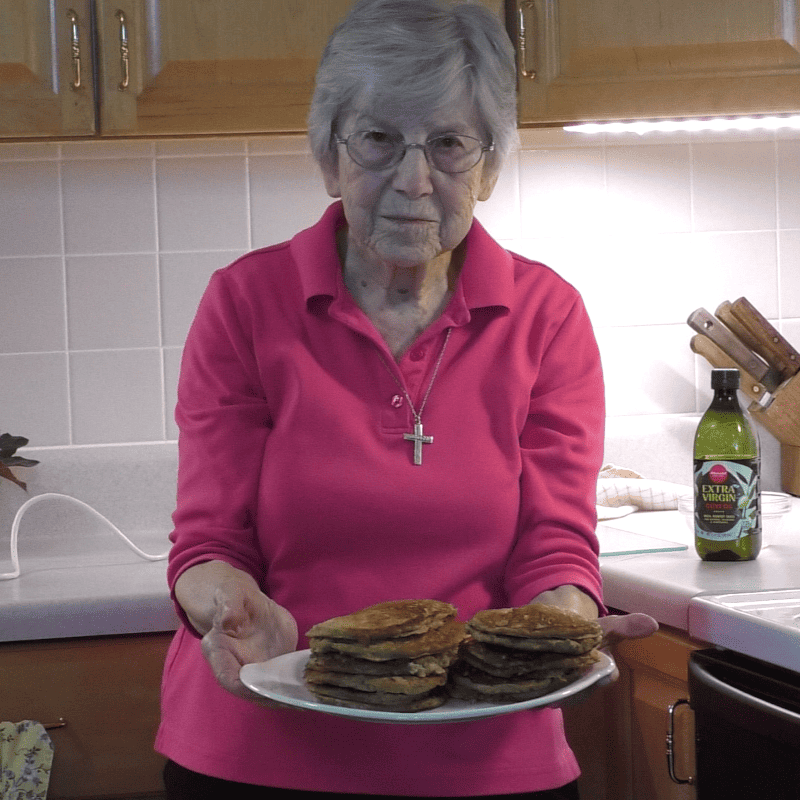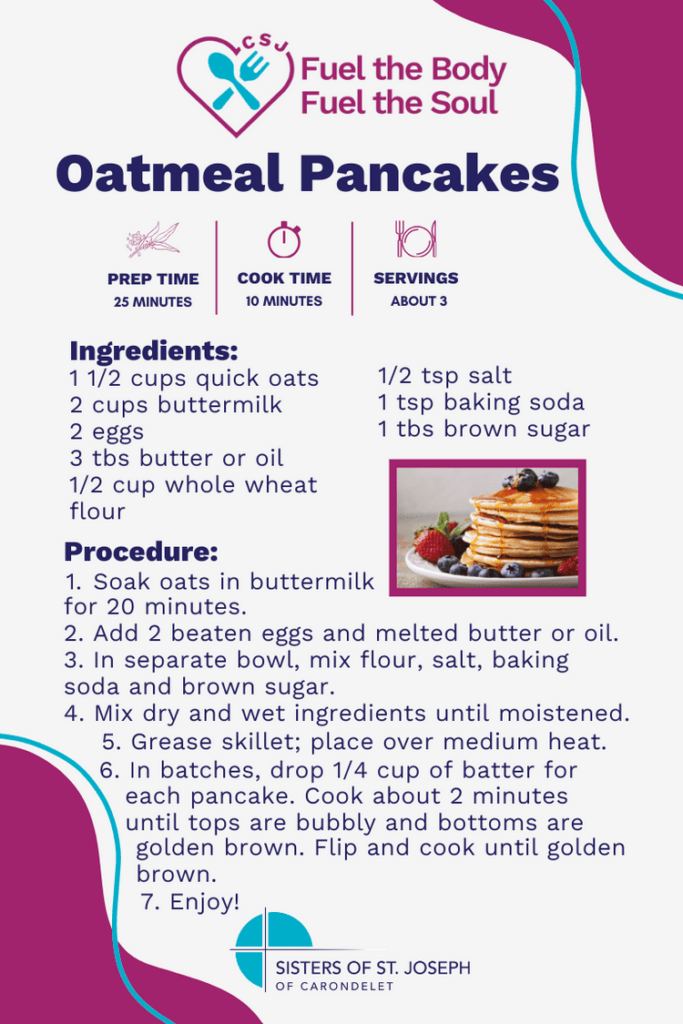When the Fuel the Body, Fuel the Soul program met on December 14, Sister Monica Kleffner showed participants her recipe for Oatmeal Pancakes. Following the recipe, Sister Sally Harper gave a presentation entitled, “Jesus, the Host with the Most.” Find the oatmeal pancake recipe and a recording of Sister Sally’s presentation below!
Fuel the Body, Fuel the Soul is a monthly series held on the second Thursday of the month. Each Zoom session features an introduction to a healthy recipe presented by a sister, a presentation focusing on a spiritual topic and discussion and prayer with a community of young women from around the country. Register once for any/all sessions. There is no cost to attend.

Oatmeal Pancakes Recipe
by Sister Monica Kleffner, CSJ

Time: 35 minutes
Servings: about 3
Ingredients:
- 1 1/2 cup of quick oats
- 2 cups of buttermilk
- 2 eggs
- 3 tbs of butter or oil
- 1/2 cup of whole wheat flour
- 1/2 tsp of salt
- 1 tsp of baking soda
- 1 tbs of brown sugar
Directions: Soak the quick oats in buttermilk for 20 minutes. Add beaten eggs and melted butter or oil. In a separate bowl, mix together the flour, salt, baking soda and brown sugar. Mix dry and wet ingredients until moistened. Grease a skillet and place it over medium heat. Once the skillet is hot, drop 1/4 cup of batter for each pancake. Cook for about 2 minutes or until tops are bubbly and bottoms are golden brown. Flip the pancakes and cook until the other side is golden brown. Enjoy!

Jesus, the Host with the Most
by Sister Sally Harper, CSJ
In Matthew 11:19, Jesus is accused of being a glutton and drunkard! “The Son of Man came eating and drinking, and they say, ‘Here is a glutton and a drunkard, a friend of tax collectors and sinners.” If we have an “otherworldly” image of Jesus, we could just mark this off to the enemies of Jesus making false accusations to sully his reputation. However, if we begin to look for the times that Jesus was “at table,” we might discover that there is some basis for the criticism.
I am sure that Jesus didn’t go to the extreme of gluttony and drunkenness, but he was a person who loved a good meal! His mother Mary was probably a good cook! And the reason that Jesus often stayed with Mary, Martha and Lazarus in Bethany when visiting Jerusalem was, in addition to their generous hospitality, that Martha was a very good cook!
But even more than the food and drink, Jesus enjoyed what is called “table fellowship,” that coming together around a table for the sharing of minds and hearts that so often occurs around a meal. Let’s discover the significance of sharing a meal in Jesus’ time and look at some examples.
First, we have to understand that in first century AD, people did not have a place setting with a knife, fork and spoon alongside an individual plate full of food. The food was served on platters in the center of the table, and each diner had bread similar to what we call pita bread today. That bread served as a “spoon” for scooping up portions of the food from the common platter and bringing it to your mouth to eat. Everyone shared from the same dish.
Now for us today, that might seem unhygienic, but for the religious leaders in Jesus’ time, there was a much greater concern over one dipping into the common platter—the danger of breaking the communion of the covenant that the Jewish people had with God. To share food with someone was to accept them. If you were a righteous person, you would NEVER dip your bread into the same platter with a person who was considered a sinner or, in other words, did not fulfill the covenant and was an outcast from the community of believers.
And then there is Jesus! He was forever eating with sinners—those pesky tax collectors and publicans! Think of his celebration with Matthew, the tax collector who left his profession to join Jesus’ band of followers. At that banquet, the pharisees question the disciples of Jesus about his behavior:
While Jesus was having dinner at Matthew’s house, many tax collectors and sinners came and ate with him and his disciples. When the Pharisees saw this, they asked his disciples, “Why does your teacher eat with tax collectors and sinners?”
On hearing this, Jesus said, “It is not the healthy who need a doctor, but the sick. But go and learn what this means: ‘I desire mercy, not sacrifice.’ For I have not come to call the righteous, but sinners.”
Matthew 9:10
And even worse, when Jesus sees the notorious chief tax collector, Zacchaeus, “up a tree,” he invites himself to dine in Zacchaeus’ house! Now it could be that Jesus heard that Zacchaeus had a great cook, but much more important is the result of Jesus sharing table fellowship with Zacchaeus. At the end of the meal, as a result of being accepted by Jesus, Zacchaeus was able to give away all his riches because he had found the treasure of being loved by Jesus:
Here and now I give half of my possessions to the poor, and if I have cheated anybody out of anything, I will pay back four times the amount. Jesus said to him, “Today salvation has come to this house, because this man, too, is a son of Abraham. For the Son of Man came to seek and to save the lost.”
Luke 19:8-10
The table fellowship that Jesus extended to so many outcasts and people on the margins was a significant “sacrament” of his ministry and became the hallmark of his all-inclusive love that left no one out of his ever-expanding circle.
Jesus also used examples of food in his parables. In Matthew 13:32, he tells a parable using the image of leaven bread to describe the way the Reign of God is kneaded into the dough of the world. “The kingdom of heaven is like yeast that a woman took and mixed into about sixty pounds of flour until it worked all through the dough.” And Jesus uses the image of the grapevine to explain the intimate connection he has with each of his followers: “I am the vine; you are the branches. If you remain in me and I in you, you will bear much fruit; apart from me you can do nothing,” (John 15:5).
Jesus also performed miracles around food. His very first miracle according to the Gospel of John took place at the wedding feast in Cana. Weddings were wonderful celebrations that lasted from three to seven days according to the wealth of the hosts. Jesus and his mother were invited to this celebration because of their connection or relationship with the family. As we know, while the celebration was still going on, the wine ran out! Bad news for the host family. Mary observes what is happening and solicits help from her son. At first, Jesus says no to his mom, but she, knowing her son so well, just turns to the caterer and says: “Do whatever he—Jesus—tells you.” We know the happy ending when Jesus orders that the stone jars be filled with water and then turns the water into wine and the wedding celebration continues.
What is interesting to note is the amount of water turned into wine. The gospel tells us that there were “…six stone water jars there for the Jewish rites of purification, each holding twenty or thirty gallons,” (John 2:6). If we do the math, Jesus provided around 180 gallons of wine. Let the party go on!!! Jesus was never stingy with his generous love for others.
Another miracle that involved food, and lots of it, is what is called the multiplication of loaves and fishes in Mark 6:30-44. This time, Jesus has been speaking to the people for some time and the disciples suggest that, given the hour, it would be good to send the people away so that they can find something to eat. Jesus answered: “You give them something to eat.” The reaction of his followers is predictable: “We only have five loaves and two fish—there is no way this will be enough for so many people. And there is no way we can buy that much food!”
In response to their incredulity, Jesus begins to organize the crowd, telling his disciples “…to have all the people sit down in groups on the green grass. So, they sat down in groups of hundreds and fifties. Then Jesus blesses those loaves and fishes, gives thanks and breaks the loaves. Then he gave them to his disciples to distribute to the people. He also divided the two fish among them all.”
There are many biblical scholars who do not see this as an abracadabra Harry Potter waving his wand moment. The explanation is that, in Jesus’ time, many people took some food with them when they left home, the same as the followers of Jesus had done. When Jesus begins to share his food, it inspired all the people gathered in groups of 50 or 100 to share their food with those around them. By pooling their resources, there is enough food for everyone! More than enough, given the amount of leftovers. The example of Jesus’ loving generosity and care for the people is contagious.
This calls us to contemplate the idea that if today the world’s resources would be shared equitably, there would be enough for everyone. Something for us to ponder and to put into action.
In the days after Jesus rose from the dead, food was also a very important factor. In one of his appearances to his disciples after the resurrection—when there are grave doubts of the disciples that this is really Jesus and not a ghost—he asks for something to eat. Eating was proof that he is really alive. And on the shore of the lake, Jesus fixes breakfast for his followers. We even have the menu: fish and bread over a charcoal fire.
Finally, we have the most important meal that Jesus ate with his followers—what we call The Last Supper. As we know, the group gathered to celebrate the Passover meal, following the Jewish tradition of remembering the night when the Jewish people were saved from suffering and death in the land of Egypt. At this meal, Jesus not only offers bread and wine, but becomes the bread and wine—his total gift of self to everyone who joins in this meal—a gift that nourishes, that gives life so that we may go out from this meal to do the same: give our lives to others. A person who is a glutton or a drunkard is someone who eats and drinks in excess. In some ways Jesus goes to excess, not to satisfy himself, but rather to give of himself totally so that we may have life and have it in abundance.
Thank you,Sally! You make the Gospel and Jesus’ words and actions come alive!